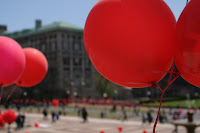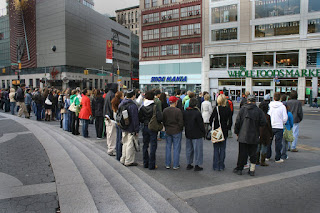
Thanks to a minor malfunction, I got to take a peek at the layers of a digital photo. I thought it might have been just strings of zeros and ones, but it's actually quite colorful.
nyc24.com's 18 reporters blog about their experiences
leading up to the launch of the Image issue, May 9, 2008.



 Back when he had Bon Jovi hair, Andre Agassi used to appear in Canon camera ads and make millions of television viewers cringe by telling them: "Image.... is everything."
Back when he had Bon Jovi hair, Andre Agassi used to appear in Canon camera ads and make millions of television viewers cringe by telling them: "Image.... is everything."
 5. Use the style guide as a rule book, yes. But use it as a guide, too. Remember that each story should have a voice - get to know these voices. Enjoy these voices. Go out for a cup of coffee with the people who produce these voices. If you chill, they'll chill. Then you'll find more voices and, from there, a theme. Then you'll feel the Zen, and you'll find your nut graph that answers the question: What is this story about?
5. Use the style guide as a rule book, yes. But use it as a guide, too. Remember that each story should have a voice - get to know these voices. Enjoy these voices. Go out for a cup of coffee with the people who produce these voices. If you chill, they'll chill. Then you'll find more voices and, from there, a theme. Then you'll feel the Zen, and you'll find your nut graph that answers the question: What is this story about? I'm doing a story on Asian eyelid surgery. It's a cosmetic surgery that's commonly performed in northeast Asia, especially in South Korea. It makes the eye opening bigger and adds a crease to the eyelid. (If you or someone you know has had it done and would be willing to talk about it with me, please get in touch ASAP!)
I'm doing a story on Asian eyelid surgery. It's a cosmetic surgery that's commonly performed in northeast Asia, especially in South Korea. It makes the eye opening bigger and adds a crease to the eyelid. (If you or someone you know has had it done and would be willing to talk about it with me, please get in touch ASAP!)

 What you think you clicked in the frame and what you see in the end should jive. Here they do not. Catching the movement, getting close enough to the subject and composing the frame is multitasking at its journalistic-ly most awesome. Sadly these photos do not display this awesomeness.
What you think you clicked in the frame and what you see in the end should jive. Here they do not. Catching the movement, getting close enough to the subject and composing the frame is multitasking at its journalistic-ly most awesome. Sadly these photos do not display this awesomeness.
"The Cleveland Plain Dealer received the Dart Award for “Johanna: Facing Forward” (Rachel Dissell, reporter; Gus Chan, photographer). This remarkable nine-day series traced events leading to the 2007 shooting of 18-year-old Johanna Orozco by her 17-year-old boyfriend. Exploring the roots of relationship violence through Johanna's eyes, the series – reported and photographed over six months - particularly struck a chord in Cleveland's Latino community and led to the creation of abuse-awareness programs for teens.I just read the story about Johanna. Wow. She'll be on the panel too.
National Public Radio received the Dart Award for "Sexual Abuse of Native American Women" (Laura Sullivan, correspondent; Amy Walters, producer; Maria Godoy, Digital Media Producer), a startling two-part investigative series that opened a new window onto a national disgrace. The series exposed both the fate of women assaulted on reservations, and the web of impunity protecting their assailants."
 It's at the Columbia University Graduate School of Journalism at 116th Street and Broadway (in the Joseph Pulitzer World Room), Wednesday, April 23, 2008, from 5:30 to 8:00 pm. Oh and it's free. Details here.
It's at the Columbia University Graduate School of Journalism at 116th Street and Broadway (in the Joseph Pulitzer World Room), Wednesday, April 23, 2008, from 5:30 to 8:00 pm. Oh and it's free. Details here.

 As you may or may not know, April is Sexual Assault Awareness Month (hence the Take Back the Night marches happening around the country). This past week was also Crime Victim Rights Week, which the Bronx District Attorney's office launched with the 12th annual Bronx Clothesline Project. The shirts are decorated by survivors of crime as art therapy.
As you may or may not know, April is Sexual Assault Awareness Month (hence the Take Back the Night marches happening around the country). This past week was also Crime Victim Rights Week, which the Bronx District Attorney's office launched with the 12th annual Bronx Clothesline Project. The shirts are decorated by survivors of crime as art therapy.


"Many say that since its controversial inception in 1988, the tone of the march has transformed from hostile to inclusive. [...] The march’s path through frat row was at one time confrontational, since, according to political theory Professor Dennis Dalton, a TBTN participant, the fraternities distributed sexist propaganda and made catcalls. Recent years have seen an attitude turnaround, as fraternities have taken to hanging signs and rallying by their windows in support of TBTN."
 Here's a photo I snapped this afternoon of banners hanging on 114th, i.e. Greek Street.
Here's a photo I snapped this afternoon of banners hanging on 114th, i.e. Greek Street. That's Dave Burdick, multimedia editor extraordinaire.
That's Dave Burdick, multimedia editor extraordinaire.
 Spring swept Columbia's campus with the usual flurry of activity on the Low Library steps a few days ago. But on this sunny April day, red balloons were everywhere. A few Israel-focused undergrad groups put up enough balloons to represent the 7,000 rockets that have been fired into Israel from Gaza since 2000.
Spring swept Columbia's campus with the usual flurry of activity on the Low Library steps a few days ago. But on this sunny April day, red balloons were everywhere. A few Israel-focused undergrad groups put up enough balloons to represent the 7,000 rockets that have been fired into Israel from Gaza since 2000.






 A passerby might wonder at the unusually large number of people strolling about Union Square at 7:45 a.m. on Sunday morning. Fifty to sixty people milled about, chatting and people watching. A girl leaned on a kiosk post reading a book. A group of girls held up a map of New York City, appearing to be lost. Most in the diverse crowd looked to be in their twenties or thirties, though a few older couples and a mother and her two young sons joined in as well. Many sported telltale Obama buttons.
A passerby might wonder at the unusually large number of people strolling about Union Square at 7:45 a.m. on Sunday morning. Fifty to sixty people milled about, chatting and people watching. A girl leaned on a kiosk post reading a book. A group of girls held up a map of New York City, appearing to be lost. Most in the diverse crowd looked to be in their twenties or thirties, though a few older couples and a mother and her two young sons joined in as well. Many sported telltale Obama buttons. A man with a white loudspeaker gave instructions to the crowd on the south side of Union Square, while several cameras were perched on the roof of Filene’s Basement across 14th Street and two police cars and an ambulance stood by. On command, the bystanders made their way briskly into formation: at the base of the steps leading to the square’s park, they formed the letters O-B-A-M-A. After a second, they raise their arms, shouted, “Obama!” and broke into cheers. The video shoot was independent of the Obama campaign.
A man with a white loudspeaker gave instructions to the crowd on the south side of Union Square, while several cameras were perched on the roof of Filene’s Basement across 14th Street and two police cars and an ambulance stood by. On command, the bystanders made their way briskly into formation: at the base of the steps leading to the square’s park, they formed the letters O-B-A-M-A. After a second, they raise their arms, shouted, “Obama!” and broke into cheers. The video shoot was independent of the Obama campaign.
